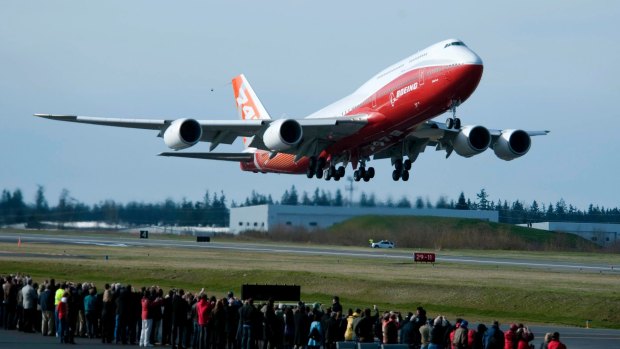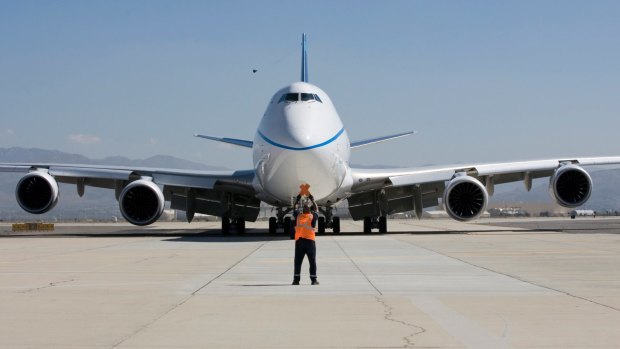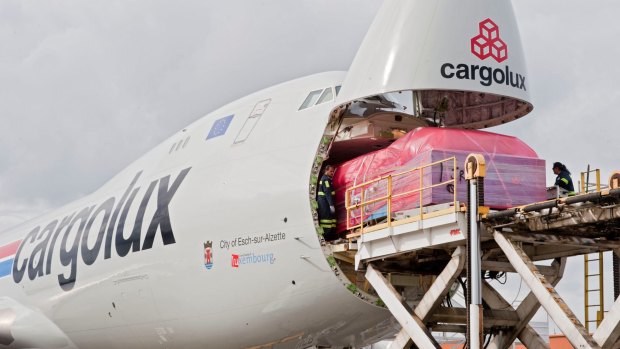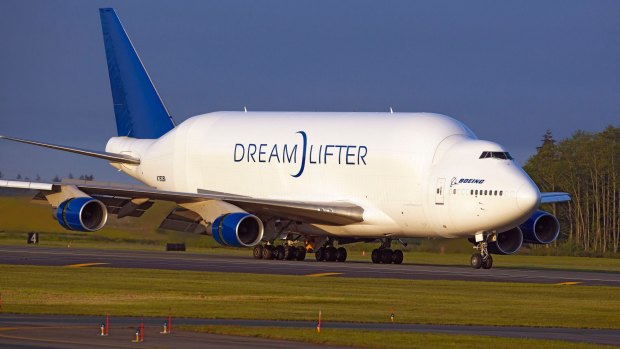This was published 5 years ago
The Boeing 747 is going to survive, for now, but not as a passenger aircraft
By Julie Johnsson
A funny thing happened to an older generation of Boeing 747 jumbo jets on their way to dusty oblivion in desert parking lots.
Instead of being scrapped, the humpbacked planes are back in demand as workhorses of global shipping. Booming trade is stoking the need for big, long-range jets to haul time-sensitive goods, from Apple iPhones made in China to fresh flowers grown in Latin America.
Interest in Boeing's 747-400 freighter family was already rebounding last year, even as Delta Air Lines and United Continental hosted nostalgic farewell tours to mark the end of US passenger service on the four-engine behemoth nicknamed the "Queen of the Skies," while Qantas announced its ageing jumbos would retire by 2021. With Boeing's factory-fresh models sold out through 2021, cargo carriers are snapping up jumbo freighters that were built from 1993 to 2009-if they can find them.
See also: Qantas announces the end of its jumbo jets
"It's tightened up, that's for sure," said William Flynn, chief executive officer of Atlas Air Worldwide, the world's largest operator of jumbo freighters. The lessor is in the process of adding six 747-400 freighters to its fleet. "There's just a finite number of aircraft," he said.
Demand is strongest for used 747s originally built as freighters, since they have hinged noses that flip open to load oversize cargo such as oil-drilling equipment. Lease rates have rebounded for the aircraft, while the number of stored models has shrunk to the point where almost every airworthy plane is spoken for, according to George Dimitroff, head of valuations for Flight Ascend Consultancy.

The latest model of the jumbo jet, the Boeing 747-8, makes its first flight in 2010.Credit: Boeing
The resurgence is even starting to extend to cargo-haulers converted from passenger jumbos, which are heavier and can load only via doors carved into the side. Once written off as dead, the converted 747 freighters have shown new life over the last nine months, Dimitroff said. While it's not quite a comeback, lease rates have climbed for older models.
One sign of the renewed interest: "We're seeing aircraft get D-checks that were in storage for a long time that we thought were going to be parted-out," he said, using an industry term for heavy maintenance. The cost, typically more than $US3 million ($A3.99 million) a plane, is an indication they'll fly again, instead of being chopped up.
To be sure, the revival involves a small subset of the 1544 jumbos that have flown away from Boeing's Seattle-area factory since the four-engine 747 debuted in 1970. There's no sign of a similar resurgence for brand-new passenger versions of the 747-8, or Airbus SE's A380 superjumbo.

The 747 remains popular as a cargo plane.Credit: BOEING
A global trade war could snuff interest in the older freighters. So would a big increase in oil prices.
"If we get to $US90 a barrel, it's going to start getting really ugly for the four-engine aircraft again," said Brian Postel, vice president for aircraft acquisition at Unical Aviation, a San Bernardino, California-based supplier of aircraft parts and maintenance. A US benchmark exceeded $US70 a barrel this month for the first time since 2014.
Still, the recent trend reverses the steady stream of 747s that had headed to boneyards this decade. Airlines switched long-range flying to more economical twin-engine models, and Boeing last year dropped the 747 from its long-term forecast for passenger planes. Package carriers parked early-build freighters amid whipsawing fuel prices and a prolonged air-cargo slump.

Demand is strongest for used 747s originally built as freighters, since they have hinged noses that flip open to load oversize cargo such as oil-drilling equipment. Credit: BOEING
The total number of permanently retired or scrapped Boeing jumbos more than doubled, from 442 in 2010 to 890 this year, according to a Bloomberg Intelligence analysis of Flight Ascend data.
"Storage is your slow march to death," Bloomberg Intelligence analyst George Ferguson said of the desert lots where old aircraft go to be raided for parts.
But starting in mid-2016, air shipments started to rebound slowly, and then in monthly leaps. United Parcel Service Inc. negotiated a freighter order that will keep Boeing's 747-8 assembly line open into the next decade. Atlas Air started lining up 747-400 freighters for customers such as DHL Worldwide Express.

The Dreamlifter is a modified 747 jumbo jet that, as the name suggests, was created to carry parts of the 787 Dreamliner. Boeing has four of the large transport aircraft. Credit: Ed Turner
The older models cost a small fraction of Boeing's $US403.6 million list price for a 747-8 freighter. In fact, Chinese package carrier SF Airlines bought two of the youngest -400s for 320 million yuan ($A67 million) last year online via Taobao, China's biggest e-commerce platform.
"That pays for a lot of fuel," Unical's Postel said.
While air-freight growth slowed in March, demand is still forecast to increase from 4 per cent to 5 per cent this year, according to the International Air Transport Association. That bodes well for all-new Boeing freighters, as well as for the used models.
Atlas Air, which has 10 of the planemaker's latest cargo version in its fleet, "would like to acquire a few more 747-8," CEO Flynn said. "We haven't said when or how many, but it's a great asset."
The cargo comeback has enabled Boeing Capital, the manufacturer's financing arm, to shrink the amount of financing it had provided to help support 747-8 sales during the slump. As of the first quarter, the exposure had shrunk to $US481 million, from $US1.07 billion a year earlier, according to a federal filing.
"The return of the cargo market has been a factor, along with BCC's expertise in placing wide-body airplanes," Joanna Pickup, a Boeing spokeswoman, said by email.
There's little chance the resurgence will extend the lives of those final Delta and United passenger 747-400 planes parked over the last year. Boeing no longer retrofits the planes to haul packages instead of people, makeovers that used to cost as much as $US30 million.
One or two of the jumbos may wind up with a boutique lessor. The rest, more than likely, will be carved up into scrap metal and spare parts to help keep the freighters flying a decade or more, said Postel. His company purchased 77 aircraft to be parted-out over the past two years, including a half dozen -400s.
"The passenger ones will be gone," he said of Boeing's best-selling jumbo variant. "The freighters have a chance."
Bloomberg
See also: Six incredible planes you'll never get to fly on
See also: 20 hours non-stop: World's longest range airliner takes off
Sign up for the Traveller newsletter
The latest travel news, tips and inspiration delivered to your inbox. Sign up now.